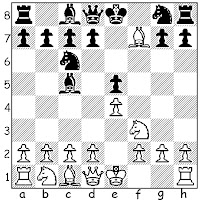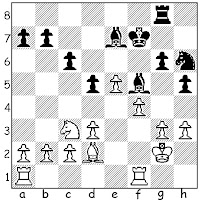Periodically in this new year we will be looking at different lines in the Jerome Gambit (1.e4 e5 2.Nf3 Nc6 3.Bc4 Bc5 4.Bxf7+) and be providing ideas (and study material) which may deliver "first aid" or heavier "fixes" in situations where White's play has been injured.
Here is a game by HauntedKnight, a regular player of things Jerome. He has 144 games in The Database, scoring an over-all 49%, which is the over-all average for White in those 27,400 games. With the Jerome Gambit proper he scores 42%, which is comparable to the 43% of all Jerome Gambit games in The Database.
HauntedKnight - Josue
standard game, FICS, 2012
1.e4 e5 2.Nf3 Nc6 3.Bc4 Bc5 4.Bxf7+
4...Kxf7 5.Nxe5+ Nxe5 6.d4 Be7
Josue, the higher-rated player, chooses a very reasonable, if unpopular line. The Database has only 12 games with this move, but White has scored only 38% against it.
7.dxe5
White avoids the ostentatious 7.f4 which brings a lot of visual excitement, but more "flash" than "bang": 7...Nc6 8.d5 Nb4 9.a3 Na6 10.0-0 Nf6 11.e5 Ne8 12.Qh5+ g6 13.Qh6 Bf8 14.Qh3 d6 15.e6+ Kg7 16.b3 Be7 17.f5 Nf6 18.Bb2 c6 19.c4 cxd5 20.Nd2 dxc4 21.Ne4 Nc5 22.Nxf6 Bxf6 23.Bxf6+ Qxf6 24.bxc4 b6 25.Qg3 Bb7 26.Qxd6 Rad8 27.Qf4 Rd4 28.Qe3 Re4 29.Qd2 Rd8 30.Qf2 g5 31.Rad1 Red4 32.Qf4 Rxf4 White resigned, wirerabbit - SimpleOne, FICS, 2007
7...d6
Alternatives include:
7...g6 8.Qd5+ Kg7 9.b3 h5 10.Bb2 Kh7 11.Nd2 c6 12.Qd3 d6 13.exd6 Bf6 14.e5 Bg7 15.0-0-0 Bf5 16.Qe2 Be6 17.h3 b5 18.g4 h4 19.f4 Bd5 20.Ne4 Bxe4 21.Qxe4 Qa5 22.Kb1 Rd8 23.g5 Nh6 24.gxh6 Bxh6 25.f5 Rhg8 26.Rhg1 g5 27.f6+ Rg6 28.e6 Qb6 29.e7 Rxd6 30.e8Q Rxd1+ 31.Rxd1, Black resigned, gollydali - Letranite, FICS, 2011;
the sturdy 7...Nh6 8.Qd5+ (8.Qh5) 8...Kf8 9.Bxh6 gxh6 10.Nc3 c6 11.Qd3 d6 12.Qf3+ Kg8 13.0-0-0 Bg4 14.Qxg4+ Kf8 15.Qf4+ Ke8 16.e6 Bg5 17.Qxg5 Qxg5+ 18.Kb1 Qxg2 19.Rhg1 Qxe4 20.Nxe4 Ke7 21.Rxd6 Rhg8 22.Rxg8 Rxg8 23.c4 Rg4 24.Rd7+ Kxe6 25.Nc5+ Kf6 26.Rxb7 Rxc4 27.Nd3 Rd4 28.Kc2 Rh4 29.Rxh7 Rxh2 30.Kc3 Kf5 31.b4 a6 32.a4 Ke4 33.Re7+ Kd5 34.Re5+ Kd6 35.f4 h5 36.Rg5 h4 37.Kc4 Rc2+ 38.Kd4 h3 39.Rh5 h2 40.Rh6+ Kd7 41.Nc5+ Kc7 42.Rh7+ Kb6 43.Rb7 checkmate, exatapalov - MeTaLoV, FICS, 2011;
the solid 7...Ke8 8.0-0 h6 9.Qg4 Bf8 10.Qg6+ Ke7 11.Nc3 c6 12.Be3 Qe8 13.Qd6+ Kd8 14.Qd4 Kc7 15.Bf4 Qe6 16.Rad1 a6 17.Na4 b5 18.Qb6 checkmate, CoachCrupp - tuffnut, FICS, 2008;
and the overly-casual 7...Nf6 8.exf6 Bxf6 returning the piece 9.0-0 Re8 10.e5 (10.Qd5+) Rxe5 11.Bf4 Re7 12.Qh5+ Kg8 13.Bg5 Bxg5 14.Qxg5 d6 15.Qh5 Re5 16.Qf3 Qe7 17.Nd2 Bd7 18.Nc4 Rf8 19.Qb3 Be6 20.Rfe1 Rxe1+ 21.Rxe1 Qf6 22.Ne3 Qxf2+ 23.Kh1 Qxe1+ 24.Nf1 Qxf1 checkmate, Howtocastle - svadali, FICS, 2003.
8.Qf3+
Probably best, although after 8.exd6 White had interesting play 8...Qxd6 9.Qe2 (9.Qf3+ Nf6 10.0-0 Bg4 11.Qb3+ Be6 12.Qxb7 Rhb8 13.Qa6 Qxa6 14.Nc3 Qxf1+ 15.Kxf1 a6 16.Be3 Ng8 17.Rd1 Rxb2 18.Bd4 Rxc2 19.Ne2 Bc4 20.Kg1 Bxe2 21.Re1 Bb5 22.f4 Rd8 23.Bf2 Rdd2 24.Bg3 Rxg2+ 25.Kh1 Rgd2 26.e5 Bc6+ 27.Kg1 Bc5+ 28.Kf1 Bg2 checkmate, Idealist - fake, FICS, 2000) 9...Be6 10.Nc3 Nf6 11.0-0 Rhf8 12.e5 Qc6 13.exf6 Bxf6 14.Qh5+ Kg8 15.Be3 Bxc3 16.bxc3 Qxc3 17.Qh4 b6 18.Bd4 Qc4 19.c3 c5 20.Rac1 cxd4 21.cxd4 Qxa2 22.Qg5 Rf7 23.f4 Raf8 24.Rcd1 Qd5 25.Kh1 Qxg5 26.fxg5 White resigned, stretto - ifufocop, FICS, 2007 (26);
Aggressive was 8.Qh5+ g6 9.Qf3+ Ke8 10.Nc3 c6 11.0-0 (11.Bf4) dxe5 12.Rd1 Qc7 13.Qg3 Nf6 14.Be3 Be6 15.Bh6 Rd8 16.Qf3 Rxd1+ 17.Rxd1 Kf7 18.Bg5 Rd8 19.Rxd8 Qxd8 20.Bxf6 Bxf6 21.h4 h5 22.Qe2 b5 23.Nd1 a5 24.Qe1 a4 25.Ne3 Bxh4 26.b3 Bg5 27.f4 Bxf4 28.Nf1 Kg7 29.g3 Bg5 30.c4 bxc4 31.bxc4 Bxc4 32.Qb4 Bxf1 33.Kxf1 Qd3+ 34.Kg2 Qd2+ 35.Kh3 Qxb4 36.a3 Qxa3 White forfeited on time, Stockholm - MorphyLives, FICS, 2007.
8...Ke8
9.Be3
Alternatives:
9.Qh5+ g6 10.Qf3 dxe5 11.Nc3 Be6 12.0-0 c6 13.Be3 Nf6 14.Rad1 Qc7 15.Bh6 Bg4 16.Qd3 Bxd1 17.Rxd1 Rd8 18.Qc4 Rxd1+ 19.Nxd1 Qd6 20.Nc3 Qb4 21.Qe6 Qxb2 22.Bg7 Qc1+ White resigned, quixote - RRustyy1, Chess.com, 2012;
9.exd6 Qxd6 10.Bf4 Qb4+ 11.Nd2 Qxb2 12.0-0 Nf6 13.Bxc7 Bg4 14.Qd3 Rc8 15.Nc4 Qb5 16.Nd6+ Bxd6 17.Qxd6 Nxe4 18.Rfe1 Be2 19.Qe6+ Kf8 20.Qxe4 Rxc7 21.Rxe2 Kf7 22.Qf4+ Kg6 23.Re5 Qb2 24.Qg5+ Kf7 25.Rae1 Qb6 26.Qf4+ Qf6 27.Rf5 g5 28.Qxc7+ Black resigned, jfhumphrey - JeversonM, FICS, 2012;
9.e6 Bxe6 10.Nc3 Nf6 11.0-0 Rf8 12.Qg3 Nh5 13.Qd3 Nf4 14.Bxf4 Rxf4 15.Nd5 Bxd5 16.exd5 Rh4 17.Rae1 Qd7 18.Re6 Kf8 19.Qf3+ Kg8 20.Rfe1 Re8 21.Qe3 Rh6 22.Rxh6 gxh6 23.Qxh6 Bf8 24.Qg5+ Bg7 25.Rf1 Qe7 26.Qg3 Qe2 27.f3 Qxc2 28.Qg4 Qg6 29.Qd7 Re2 30.Qc8+ Bf8 31.Qh3 Rxb2 32.f4 Rxa2 33.f5 Qg5 34.f6 Qxd5 35.f7+ Kh8 36.Qg3 Qd4+ 37.Kh1 Qg7 38.Qf3 c5 39.h4 c4 40.Qxb7 c3 41.Qf3 c2 42.h5 Rb2 43.Kh2 c1Q 44.Rxc1 Qe5+ 45.Kh3 Qe6+ 46.Kh2 Rb4 47.Qc3+ Qe5+ 48.Qxe5+ dxe5 49.Kh3 Kg7 50.Rf1 h6 51.g4 a5 52.Rf5 Rb3+ 53.Kh4 Be7+ 54.g5 Bxg5+ 55.Kg4 Rb4+ 56.Kf3 e4+ 57.Ke2 Rb2+ 58.Kd1 Kf8 59.Rxa5 Kxf7 60.Rf5+ Ke6 61.Rf8 Ke5 62.Re8+ Kd4 63.Rd8+ Ke3 White resigned, jfhumphrey - fischbroetchen, FICS, 2011;
Probably best is 9.Bf4 dxe5 10.Bxe5 Nf6 11.0-0 Bd6 12.Bd4 c5 13.e5 cxd4 14.exd6 Qxd6 15.Re1+ Kf8 16.Na3 Kg8 17.Nc4 Qc6 18.Qb3 Be6 19.Rxe6 Qxe6 20.Qxb7 Rf8 21.b3 h5 22.Qxa7 Qg4 23.h3 Qf4 24.Re1 Rh7 25.Re7 g5 26.Rxh7 Nxh7 27.a4 Qxf2+ 28.Kh2 Rf7 29.Qa8+ Kg7 30.Qd5 g4 31.hxg4 hxg4 32.Qd6 g3+ 33.Qxg3+ Qxg3+ 34.Kxg3 Ng5 35.Kh2 Ne4 36.g3 Rf2+ 37.Kh3 Rxc2 38.Kg4 Rc3 39.Kf4 Rxb3 40.Ne5 Rb4 41.Ng6 Rxa4 42.Ne7 Kf7 43.Nf5 Nxg3 44.Nd6+ Ke7 45.Nf5+ Ke6 46.Nd6 Kd5 47.Kg4 Kxd6 48.Kg5 drawn, soonFM - vessoj, FICS, 2005.
9...Nh6
Black is planning something wicked, a threat that shows up in several of the above games. Probably his best move was 9...dxe5.
10.Nc3
It is prudent to note here that White can take the draw with 10.Bxh6 gxh6 11.Qh5+ Kf8 12.Qf3+ Kg7 13.Qg3+ Kf7 14.Qf3+ Kg8 15.Qb3+ Kg7 16.Qg3+ Kf7, etc.
If White wants to play on, it would seem that 10.Qh5+ Nf7 11.exd6 followed by 12.Nc3 would be best.
10...Bg4
The unhappy point: White will lose his Queen.
11.Qg3 Bh4 12.Qf4 Rf8 13.Qxf8+ Kxf8
White continued the fight, but it was too much.
14.g3 Bg5 15.f4 Be7 16.Kf2 Qe8 17.h3 Bd7 18.Ke2 dxe5 19.fxe5 Qh5+ 20.Kd2 Bg5 21.Rae1 Bxe3+ 22.Rxe3 Qxe5 23.Kc1 Kg8 24.Rd1 Bxh3 25.Rd5 Qf6 26.b3 Rd8 27.Rc5 Qf2 28.Nd5 Rxd5 29.Rec3 Rxc5 White resigned











































